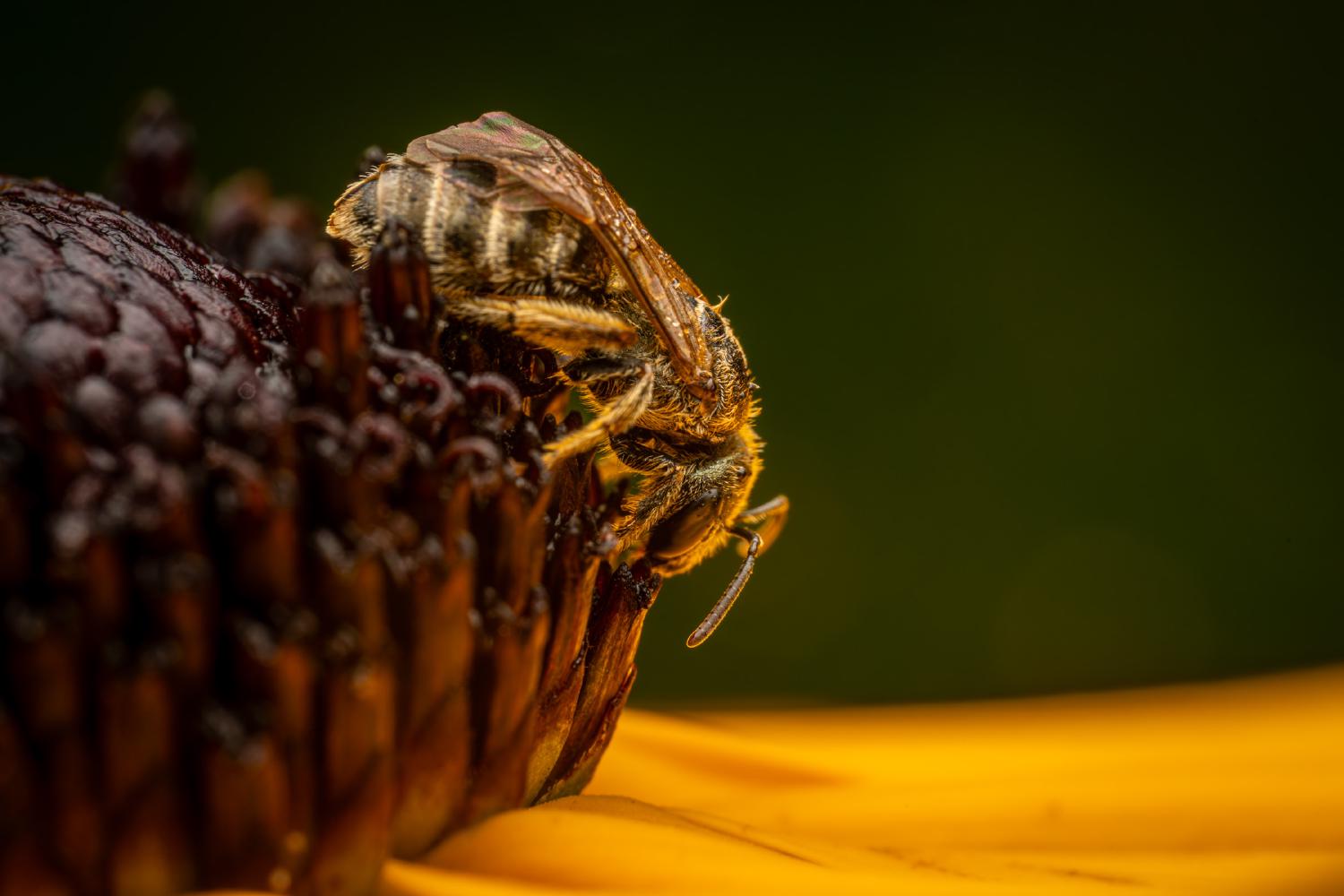Bees
Lat. “Anthophila“
epifamily
of infraorder
“Ants, Bees, and Stinging Wasps“
1 epifamily, 3 families, 3 genus, 23 species
Bees evolved from stinging wasps and made a switch from feeding on insects to feeding on pollen. They originated during the Early Cretaceous on the supercontinent of West Gondwana before it broke up into South America and Africa. Bees have undergone diversification and spread across different continents over the course of millions of years. They have specific characteristics such as compound eyes, geniculate antennae, adaptations for chewing and sucking, membranous wings, and a modified stinger. The largest species is Wallace’s giant bee, while the smallest species are the dwarf stingless bees.
Hierarchy
Evolution
The immediate ancestors of bees were stinging wasps in the family Crabronidae, which were predators of other insects. The switch from insect prey to pollen may have resulted from the consumption of prey insects which were flower visitors and were partially covered with pollen when they were fed to the wasp larvae. This same evolutionary scenario may have occurred within the vespoid wasps, where the pollen wasps evolved from predatory ancestors. Based on phylogenetic analysis, bees are thought to have originated during the Early Cretaceous (about 124 million years ago) on the supercontinent of West Gondwana, just prior to its breakup into South America and Africa. The supercontinent is thought to have been a largely xeric environment at this time; modern bee diversity hotspots are also in xeric and seasonal temperate environments, suggesting strong niche conservatism among bees ever since their origins.Genomic analysis indicates that despite only appearing much later in the fossil record, all modern bee families had already diverged from one another by the end of the Cretaceous. The Melittidae, Apidae, and Megachilidae had already evolved on the supercontinent prior to its fragmentation. Further divergences were facilitated by West Gondwana’s breakup around 100 million years ago, leading to a deep Africa-South America split within both the Apidae and Megachilidae, the isolation of the Melittidae in Africa, and the origins of the Colletidae, Andrenidae and Halictidae in South America. The rapid radiation of the South American bee families is thought to have followed the concurrent radiation of flowering plants in the same region. Later in the Cretaceous (80 million years ago), colletid bees colonized Australia from South America (with an offshoot lineage evolving into the Stenotritidae), and by the end of the Cretaceous, South American bees had also colonized North America. The North American fossil taxon Cretotrigona belongs to a group that is no longer found in North America, suggesting that many bee lineages went extinct during the Cretaceous-Paleogene extinction event.Following the K-Pg extinction, surviving bee lineages continued to spread into the Northern Hemisphere, colonizing Europe from Africa by the Paleocene, and then spreading east to Asia. This was facilitated by the warming climate around the same time, allowing bees to move to higher latitudes following the spread of tropical and subtropical habitats. By the Eocene (~45 mya) there was already considerable diversity among eusocial bee lineages. A second extinction event among bees is thought to have occurred due to rapid climatic cooling around the Eocene-Oligocene boundary, leading to the extinction of some bee lineages such as the tribe Melikertini. Over the Paleogene and Neogene, different bee lineages continued to spread all over the world, and the shifting habitats and connectedness of continents led to the isolation and evolution of many new bee tribes.
Characteristics
Bees differ from closely related groups such as wasps by having branched or plume-like setae (hairs), combs on the forelimbs for cleaning their antennae, small anatomical differences in limb structure, and the venation of the hind wings; and in females, by having the seventh dorsal abdominal plate divided into two half-plates.Bees have the following characteristics:
A pair of large compound eyes which cover much of the surface of the head. Between and above these are three small simple eyes (ocelli) which provide information on light intensity. The antennae usually have 13 segments in males and 12 in females, and are geniculate, having an elbow joint part way along. They house large numbers of sense organs that can detect touch (mechanoreceptors), smell and taste; and small, hairlike mechanoreceptors that can detect air movement so as to “hear” sounds. The mouthparts are adapted for both chewing and sucking by having both a pair of mandibles and a long proboscis for sucking up nectar. The thorax has three segments, each with a pair of robust legs, and a pair of membranous wings on the hind two segments. The front legs of corbiculate bees bear combs for cleaning the antennae, and in many species the hind legs bear pollen baskets, flattened sections with incurving hairs to secure the collected pollen. The wings are synchronised in flight, and the somewhat smaller hind wings connect to the forewings by a row of hooks along their margin which connect to a groove in the forewing. The abdomen has nine segments, the hindermost three being modified into the sting.The largest species of bee is thought to be Wallace’s giant bee Megachile pluto, whose females can attain a length of 39 millimetres (1.54 in). The smallest species may be dwarf stingless bees in the tribe Meliponini whose workers are less than 2 millimetres (0.08 in) in length.
See also
Australian native bees Fear of bees (apiphobia) Superorganism World Bee Day
External links
“Bees”. Encyclopedia of Life. “Apoidea” at All Living Things – images, identification guides, and maps of bees Bee Genera of the World Anthophila (Apoidea) – Bees – North American species of bees at BugGuide Native Bees of North America at BugGuide “Bee declines driven by combined stress from parasites, pesticides, and lack of flowers” – Science
Ancestry Graph
Further Information
Copyright

This article uses material from the Wikipedia article Anthophila the free encyclopedia Wikipedia which is released under Creative Commons Attribution-ShareAlike 4.0 International License). On Wikipedia a list of authors is available.
